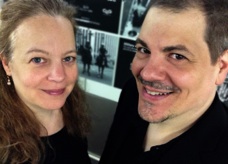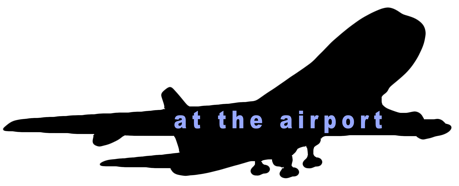
NEW

Newark in 3D
FIRST FILM AT NEWARK AIRPORT
Question: How did you conceive of NEW WORK: Newark in 3D at the Airport?
We live in Newark. With a very high poverty rate near 32%, we're working to reduce Newark's poverty and improve the city by taking on projects that provide solutions and promote the city. One of the major benefits of living in Newark is that you’re only 5 minutes away from an international airport. But when traveling through the Airport, we’ve never felt that it adequately represented Newark. Some time after installing NEW WORK: Newark in 3D at the Museum, on our way through the airport to a flight for a screening of Revolution '67, Marylou got the idea to screen NEW WORK: Newark in 3D at the Airport. Since we had filmed at the Airport for New Work, there was that connection. And also, it was important to us to use the Airport as "art gallery." Airports are excellent, yet underused, places to exhibit art.
Question: New Work, like all of your work, is public.
Yes, screening free for the public has become a very important aspect to our work. We work hard to get sponsors so that we can make these films available to the public at no cost to them.
Question: How do the two of you divide your efforts when approaching a project?
With all our projects, Marylou deals with the public and bureaucratic side including fundraising, while Jerome focuses on the technical.
Question: What were some of the highlights on getting New Work at the Airport?
In 2009, we met John Jacoby when he was a Board Member of the Newark Museum and GM of Newark Airport. He and Valerie Pratt made it possible for us to climb a rooftop and place our cameras many feet apart to capture in 3D the former Continental Airlines jets touching down on the runway.
After NEW WORK: Newark in 3D was exhibited at the Museum in a solo gallery for five months, we reconnected with John about the installation of the film at the Airport. He suggested Westfield, the company that handles concessions on site, as a possible sponsor of the 3D Glasses. Over the course of a few years, we made formal proposals to the PANYNJ and scouted many spaces until this one, that we've christened "The Gallery," became available, after a long wait. Chris Perez, who manages Terminal B, was part of the team we worked with on the installation. He studied how the film was originally exhibited at the Museum and suggested this cavernous space, which was painted charcoal gray and resembles an artist's loft. On our first site visit, we immediately embraced his vision for the film. The Terminal B3 Connector is accessible to international connecting flight passengers, averaging 2000 travelers per day. The large monitors in the Relax and Recharge Lounge are watched by 500 visitors daily. Welcome Center monitors in all three Terminals loop the film's Trailer. In under one month, we and the entire team worked hard to prep the gallery and lounge and install the projection before Thanksgiving, the most highly trafficked weekend of the year. Nearly 30,000 3D Glasses, weighing 322 lbs., arrived the day before the holiday, our official opening. The exhibit will run through January 10, 2014. We’re excited to say that NEW WORK: Newark in 3D is the first film at Newark Airport.
In addition to the team at the airport, the gallery also took shape with the talents of the Newark Museum's Exhibition Designer, Tim Wintemberg. In creating the signage, Tim incorporated elements from the Newark Museum installation, establishing continuity with the film's origins, with the addition of eye-catching film still images, surprising facts about Newark, and graphics.
The exhibition was also made possible thanks to the loan of a projector from SONY, and donations of their Blu-Ray players; the 2:1 sound system from Roland; the special reflective screen paint from DIY Theatre; and digital A/V cables from C2G, along with funding from our sponsors.
Question: What are the challenges when exhibiting a piece in 3D?
For public viewing, you have to make sure that the venue is comfortable and user friendly. We chose a screen size of about 13’ x 10' so the distance of the seating would maintain good depth on the 3D while providing comfortable divergence. Divergence is the distance between the left and right 3D elements. You have to be conscious of this when shooting as well as when projecting. If the divergence is too great, the average viewer cannot converge the pictorial elements and will get a headache. Plus, the gallery has to be comfortable, with good seating, and be meditative. These were our goals for the Newark Museum and we kept the same goals for the Airport. Once in the space, we wanted the viewer to appreciate what's endured in Newark and also gain some peace while traveling. This installation, as well as the large monitors in the Relax and Recharge Lounge, project an art film to an eclectic global audience that may only "see Newark" via the Airport.
The Airport stocked nearly 30,000 disposable 3D Glasses for this exhibition.
Question: What are the challenges to getting your art exhibited in a major venue like Newark Liberty?
Biggest challenge is persevering, even when the project appears to be stalled.
On our wall is a photo of the two of us on a winter's night in Central Park in 2005, under one of the saffron curtains of The Gates by Christo and Jeanne-Claude. It serves as a reminder that the artists financed the project (21 million) in order for it to happen. Recently, we read the interview below, and it gives us a stronger kick to persevere:
First proposed in 1979, The Gates were then 12 feet tall, of a totally different design, and the first drawing was titled The Thousand Gates. The project was rejected in 1981 but ultimately approved on January 22, 2003 by Mayor Michael R. Bloomberg, for completion in February 2005.
[Christo and Jeanne-Claude quoted in http://www.nyc.gov/html/thegates/html/qanda.html]
Question: Why anaglyph?
There are various ways of exhibiting 3D. We decided early on that New Work had to be able to be projected so that it could be seen by many people at once - but not be cost prohibitive, too tekkie, and too tedious to get on its feet. So we decided to edit in anaglyph. Anaglyph allows us to easily project using only one conventional projector, as well as low cost glasses to filter the image. Any other system would have been too expensive. When shot and edited correctly, anaglyph, especially in B&W yields very clear, crisp and effective 3D. Plus, anaglyph glasses are useful even after viewing the film; they're the only way to see 3D on the internet - so keep those glasses! Also, we decided to create New Work in a 4:3 aspect ratio and edit in B&W because we originally used the Strand and Sheeler 1921 city symphony film Manhatta (in the Newark Museum's collection) as our inspiration.
Question: What's a city symphony?
Oooh, these are fabulous avant-garde films from the 1920s and 30s that celebrate (and criticize) but most importantly, record, cities like Berlin, Nice, and Moscow, capturing moments in time that are ever changing.
Question: Next Project?
We've got a ton of projects in the works. Our last documentary, REVOLUTION ’67, which had a long run on the PBS series POV and is currently on STARZ, is the basis of a fiction project called "Ready to Riot," about the Newark riots/rebellion of 1967, Executive Produced by Spike Lee. Its sequel is THE RULE, currently in previews, about the Benedictine monks of Newark Abbey and the success of their school for inner city young men, St. Benedict's Prep, as a model for urban school reform. "Monks in the 'Hood" is the fictional screenplay we co-wrote with Fr. Albert, one of the monks, set in 1972, the year the school reopened. We're also prepping the third in this 3R's Trilogy of Inner City Films called RUST about solutions to the resultant poverty in US RustBelt cities. Through our research, over the past decade, it's become painfully clear to us that poverty is why cities like Newark, Camden, Trenton, Detroit and Cleveland are suffering. To improve our cities, we must reduce the poverty.
Another documentary, END DEPENDENCE, is also in production, and documents NJIT architecture students designing and building a zero energy house. We're also shooting a series of fiction shorts in the theme of Love & Arguments.
And, finally, we'll soon be returning to 3D to film our third NEW WORK city symphony called SI3D for the Staten Island Museum (the second, NEW WORK: The Brooklyn Waterfront in 3D, was presented at the Museum of the City of NY in 2010), as well as "WATERMARK," a fictional environmental love story set in Venice, Italy. Why in 3D? For those with binocular vision, 3D can clear up confusion about the location of objects in space. So, 3D, to us is a very useful metaphor. Plus, 3D - Venice - Love story - that's cinematic!



November 27, 2013 - September 2014
(10 month Extended Run!)
NEW WORK: Newark in 3D - AT NEWARK AIRPORT
MARYLOU & JEROME: IN THEIR OWN WORDS.












